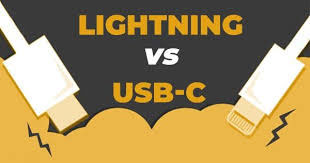USB Type-C
USB-C is the industry-standard connector for transmitting power as well as data. It’s bi-directional, so a device can either send or receive power. It is known to handle up to 100 watts and 20V/5A charge speed with the USB Power Delivery technology. This makes sense for laptops, which generally requires up to on 60 watts. In addition, USB-C supports video signals at the same time of power streams. This means that we can connect and power a native Display Port, MHL, or HDMI device or connect to almost anything else assuming you have the proper adapter and cables. Type-C data cable can able to be compatible with the old USB standard, but users need to purchase an additional adapter to complete the compatibility. It has low-priced as compared to lightening connector.
Lightening connector
The Lightning connector is exclusively used to connect Apple mobile devices like iPhones, iPads, and iPods to host computers, external monitors, cameras, battery chargers, and other peripherals. It has maximum current over 2A current and transmission rate is about 25MB/S-35MB/S.
USB Type-C is still quite large compared to the flat Lightning plug. Compared to the USB Type-C, it’s easier to connect to a product. And it has another advantage: if stress put on a USB Type-C cable is more likely to damage the Smartphone, whereas if stress put on the Lightning connector is more likely to harm the cheaper, replaceable cable. It has some disadvantage like Charging and data transmission is slow as compared to USB type c. It’s Audio output of analog signals is not supported. The price is expensive, and the chip encryption protection, third-party manufacturers also need to authorize MFI and other technical certification to allow production.
